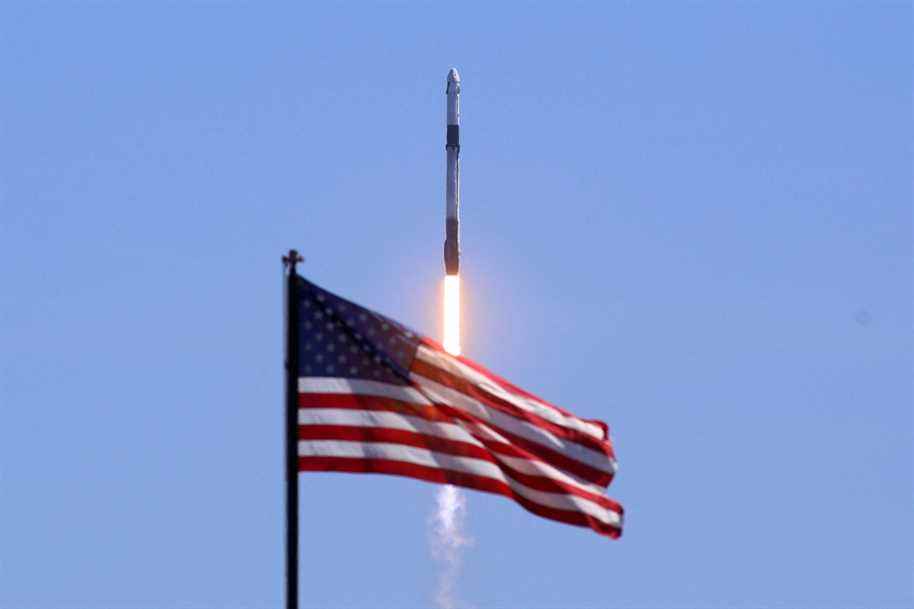(Washington) Three businessmen and a former NASA astronaut took off on a SpaceX rocket on Friday for the first fully private mission to the International Space Station, where they will stay for just over a week.
Posted at 12:06 p.m.
Liftoff took place at 11:17 a.m. local time from Kennedy Space Center under blue skies over Cape Canaveral, Florida.
Novices have already visited the space station (ISS), especially in the 2000s. Last year, Russia sent a film crew there, then a Japanese billionaire. But these flew aboard Soyuz rockets, accompanied by cosmonauts.
This time, it was the Axiom Space company which organized the trip, in collaboration with SpaceX and NASA, paid for the use of its station.
“We are expanding the land borders of trade to space,” said Bill Nelson, the head of the American space agency, shortly before takeoff.
The commander of the mission, named Ax-1, is the American-Spanish Michael Lopez-Alegria, a former astronaut of the American space agency, who has already visited the ISS.
The other three crew members paid tens of millions of dollars each for the experiment. The role of pilot is occupied by the American Larry Connor, at the head of a real estate company.
Also on board: Canadian Mark Pathy, owner of an investment company, and ex-pilot Eytan Stibbe, co-founder of an investment fund.
The latter is the second Israeli astronaut in history, after Ilan Ramon, who died in 2003 in the explosion of the American space shuttle Columbia, on his return from the ISS.
“He was a good friend,” Mr Stibbe told a news conference last week. “I will continue an experiment he started 19 years ago, focused on observing storms,” he said.
Scientific experiences
The four men have a busy program, with some 25 experiments, on aging, heart health, or even stem cells.
“The experiments that I take up there, which come from Canadian universities and research institutions, would probably not have had the opportunity to be tested in space” without this mission, argued Mark Pathy.
For this reason among others, the members of Ax-1 refuse to be called space tourists.
“I think it’s important to differentiate space tourists from private astronauts,” said Larry Connor. The former “spend 10 to 15 hours training, five to 10 minutes in space. […] We spent between 750 and over 1000 hours training. »
He and Michael Lopez-Alegria were trained on SpaceX’s capsule system, Dragon.
And all of them have learned how to react in the event of an emergency at the station. But also to carry out tasks of daily life, such as washing in weightlessness.
However, their training is less advanced than that of professional astronauts, who must be able to carry out spacewalks or even repair equipment.
The members of Ax-1 “will use the toilets, but if they break, our crew will fix them,” NASA official Dana Weigel said Thursday.
Future private station
The Dragon capsule is due to dock with the ISS on Saturday around 7:30 a.m.
Upon arrival, the crew will receive a guided tour of the station and then get to work.
This is only the sixth time SpaceX has flown humans (the fifth to the ISS). The first flight took place less than two years ago.
Axiom Space has an agreement for a total of four missions with SpaceX, and NASA has already formally approved the principle of a second, Ax-2.
For Axiom Space, this is a first step towards an ambitious goal: the construction of its own space station.
“It’s important for us to be able to repeat” such missions “on a smaller scale,” said Michael Suffredini, the company’s boss.
The first module of this private station should be launched in September 2024. The structure will first be attached to the ISS, before becoming autonomous when the latter is retired, a priori around 2030.
This movement to privatize low orbit is encouraged by NASA, which wishes to generate income through these private missions, and in the long term, no longer have to manage the operation of a station, but rather hire the services of private structures. , in order to focus on distant exploration.
